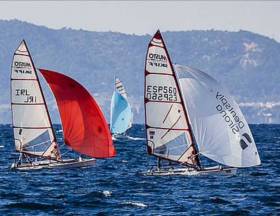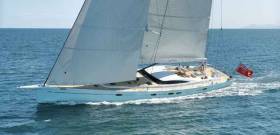Displaying items by tag: Tim Goodbody
Goodbody Wins OK Dinghy Mid-Winter Regatta in Mallorca
Dun Laoghaire Harbour's Tim Goodbody Junior scored a significant victory when he won the Palma OK dinghy mid-winter regatta in Mallorca last weekend.
The 2008 Royal Irish Yacht Club Olympian was part of a 15-boat fleet from six nations gathered on Spanish Island for the seven-race event.
Multiple world champion, the UK's Nick Craig boosted the fleet in a warm-up event before he competes at next month's class world championships in Brisbane, Australia.
The Mallorcan fleet hopes to reach 20 boats as it prepares to stage the Europeans at Real Club Náutico de Palma.
Royal Irish's Tim Goodbody Lying Fourth at OK Dinghy European Championship
Britain’s Nick Craig has taken the lead at the 2023 OK Dinghy European Championship on Lake Garda with Charlie Cumbley in second, Germany’s Jan Kurfeld in third, and Dun Laoghaire Olympian Tim Goodbody Junior fourth (racing under Spanish sail insignia) with just one day left to sail.
There are 115 entries from 15 nations.
The third day started with light rain, cloud cover and little hope of racing, but by 10.00, conditions had improved, and in the end, it was the best day of racing so far with three more fantastic races in 10-18 knots, sunshine and beautiful conditions.
While many of the leaders struggled in the first race after a big right shift, Craig took the next two race wins in the gold group to lead into the final day by three points. Cumbley scored 3-9-4 to move up to second, while a 2-6-8 from Kurfeld dropped him to third.
In the silver fleet, the race wins went to Britain’s Simon Cox, Germany's Niels Timm and Sweden’s Thomas Uziel.
Highlights from Day 3
Race 6
Bo Petersen is in seventh overall. “It’s always special here. The wind comes after lunch, and then we go sailing. It’s nice to have a regatta when you have the morning and take it calm and be ready. Garda is a nice place for sailing.
“I just turned 60, and Garda is windy, and I am small. I can feel my age. I am still a horse when I am out here, but in the evening, need some pils.”
On the racing, “Ups and downs. The first three races were easy, and then I had a bad one. Sometimes it is tricky out there. Today, my watch stopped, and I had a bad start and went left. It’s been a tough day, but a lot of guys also had a bad race so looking forward to seeing the results.”
Craig said, “Good overall. First race was poor. The windward mark was left, so I thought left would pay, so I got out left and rounded the first mark fifth from last.
“So the day didn’t start well, but then I won the next two, so didn’t make that mistake again and went right in the next two races.”
Craig has sailed on Garda in a number of classes but, “I’ve been looking forward to this for a long time. It’s great to sail in a huge fleet and great the sail in the OK against a really high-standard fleet. All the things I know about Garda were useful apart from the first race today."
Tim Goodbody of the Royal Irish Yacht Club, but now based in Spain, scored a 27-3-2 and is in fourth overall.
“In Race 1 I started near the pin, but no one wanted to tack so we went left, and it never really came back. About seven of us in the top ten were almost last, but we climbed back up to mid-fleet. Next race I was third, a bit tricky, but kept working the right, and in the last, Nick and I had a good battle, and I had a second.
“It’s always amazing here. I didn’t think the wind would be that good, but it just came out of nowhere, and it was perfect Garda conditions.”
The championship concludes on Thursday with two more races scheduled.
Results after eight races (download full results below as a pdf)
1 GBR 2261 Nick Craig 16
2 GBR 6 Charlie Cumbley 19
3 GER 18 Jan Kurfeld 24
4 ESP111 Tim Goodbody 28
5 GBR 2279 Matt Howard 28
6 DEN 12 Jens Eckardt 36
7 DEN 21 Bo Petersen 45
8 GER 71 André Budzien 46
9 SWE 100 Thomas Hansson-Mild 50
10 DEN 24 Steen Christensen 53
2008 Irish Finn Olympian Tim Goodbody, a member of the Royal Irish Yacht Club, has been putting his sailing skills to good use on both sides of the Atlantic this month with a win in the Caribbean on the 33-metre superyacht WinWin where he sailed as a tactician at the St Barths Bucket Regatta before taking a comprehensive win on his home waters of Palma de Mallorca at the BM Composites OK Dinghy Regatta.
Goodbody – who won all seven races – has been involved locally in building a local OK Dinghy Fleet in Palma, and they have been getting a number of sailors coming to Palma from various countries for a week or weekend to enjoy the lovely Majorca winter weather and get some sailing and racing in as well.
Fifteen boats were represented at last weekend's event, including Ireland, the UK, Denmark, Germany, Spain, and Australia. Conditions ranged from 7. to 14 knots in a mix of sea breeze and gradient winds.
"It would be great if the class develops further here in Palma, and maybe we can get a few more Irish to come down for a short break, Godbody told Afloat.
 BM Composites OK Dinghy Regatta
BM Composites OK Dinghy Regatta
Goodbody's adopted port of Palma is hosting the 52nd edition of the Trofeo Princesa Sofía, which runs from this Wednesday 29 March to Friday 8 April on the Bay of Palma and marks the start of a crucial season for the teams in the run-up to the Paris 2024 Olympic Games.
Tim Goodbody Second in Mallorca Musto Skiff Event
Former Irish Finn helmsman Tim Goodbody from Dun Laoghaire has finished second overall in Mallorca's Nova Beach Park Trophy, sailing a Musto skiff.
The 2008 Olympian from the Royal Irish Yacht Club, who admits to being 'a little over weight' for the 4.55m metre boat, does not appear to have been slow in the lightweight skiff.
Goodbody was two points off the title, taken by the host club's own Justo Martinez Balaguer, in a ten–boat fleet at Club Nautic Arenal in Mallorca.
The Musto Skiff is a single-handed sailing skiff with a length of 4.55m. It features a trapeze, asymmetrical spinnaker, wings and low hull weight.
Never the one to miss an opportunity to try out a new dinghy or race course, in 2016, Goodbody Jnr completed the Round Antigua race covering the course of just over 50nm in a Laser dinghy in a time of 10 hours and 48 minutes as Afloat.ie reported at the time here.
Full results from Mallorca here.
Irish Sailors Still Well Up in RORC Caribbean 600 Mix
Maybe it’s because the weather has been unseasonably like home at times out in the Caribbean, but the Irish sailors spread through the RORC fleet have been in the racing frame through a wet cold front from the nor’west. For a while, it turned sunshine hopes upside down, but the Micks in the mix are on boats which have been showing mighty well since last’s night’s posting, when top navigator Ian Moore on Bella Mente was leading the fleet on IRC writes W M Nixon.
The first of the multi-hulls, Lloyd Thornburg’s MOD 70 Phaedo 3 with Damian Foxall on the strength, has already taken line honours in 33 hours. But further down the line, the pendulum of fortune has swung back and forth as monohull boats of hugely varying sizes take on the challenges of a real cat’s cradle of a course.
The vagaries of fortune are revealed by the fact that for some hours this morning Irish time, the overall leader was the superyacht Dannesskjold, whose crew include Tim Goodbody, Aine Hanevy, and Paul O’Donoghue, while the Kinsale-registered Lilla was third. But the most recent set of figures show that Dannesskjold has plunged to 32nd overall, while Lilla plunhed to 48th, and the best-placed Irish sailor is now Marcus Spillane, originally of Cork, now San Francisco-based, an ISA Board Member and representative on World Sailing.
He also presides over the 49er International Association and the Nacra 17 Association, but currently his focus is on getting the best performance out of the Swan 66 Bounty in the Caribbean 600, and they lie third overall, 20 minutes or so ahead of George David’s Rambler 88 in fourth, and 45 minutes ahead of Bella Mente in 5th. Yet while Phaedo may be well finished, but there’ll be many twists of failure and fortune before we get the final IRC placings.
Tim Goodbody Is Afloat.ie 'Sailor Of The Month' For November
Veteran Royal Irish YC sailor Tim Goodbody is the Afloat.ie “Sailor of the Month” for November for his enormous contribution to Irish and international sailing over many decades, both as an active participants, as a race organiser, and as an administrator of leading sailing organisations.
By locating the award in November 2015, we highlight the fact that at the Dublin Bay SC Annual Prize-Giving on November 15th in the Royal St George YC, three generations of the Goodbody family received major awards. Grandson Max took The Mitchell Trophy in the RS Feva with granddaughter Georgia crewing, while son Richard - in partnership with Rick Johnson racing the International Dragon Diva - won the Oxford & Cambridge Cup, the Old Time Cup, and the RIYC Cup. And Tim himself, in his final season with the Sigma 33 White Mischief (he has now moved on to a J/109), won the J.B.Stephens Trophy, the Bective Lights Crystal Trophy, and the Fireseal Sigma 33 Trophy.
Both Tim and Richard were overall winners in their respective classes in the combined DBSC Thursday and Saturday season-long series. But while this shows the family’s devotion to Dublin Bay sailing, both White Mischief and Diva were also seen in major events at other venues, with White Mishchief taking second overall (by just two points) in Class 3 IRC at the ICRA Nats at Kinsale).

Although the Sigma 33 is not reckoned a favoured performer under IRC, Tim Goodbody still sailed White Mischief to a close second overall in IRC Class 3 at the ICRA Nats at Kinsale at the end of June. Photo: ICRA
The timing of the ICRA Nats at the end of June could just be fitted into Tim Goodbody’s busy schedule, for as Chairman of the Organising Committee for the Volvo Dun Laoghaire Regatta 2015 from July 9th to 12th, he was out of personal boat-racing for the next two weeks as the structures of the biggest sailing event in Ireland in many years swung successful into place, with the noted Goodbody light-but-effective management style keeping this very complex event moving smoothly forward to a happy conclusion.
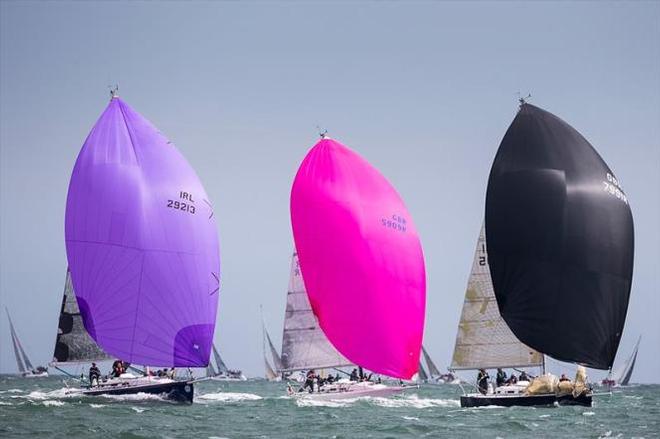
J/109s in full flight at the hugely successful Volvo Dun Laoghaire Regatta 2015, for which Tim Goodbody was Chairman of the Organising Committee. In 2016, he will himself be joining the J/109 class. Photo: VDLR
But then the depth of Tim Goodbody’s commitment to every aspect of sailing is unrivalled. He has campaigned successfully to international level in the Dragon, the J/24 and the Sigma 33, and as well he was lead helm on Irish Independent, the Dubois 40 which was the backbone of Ireland’s 1987 Admirals Cup team - our most successful AC squad ever, they placed fourth out of thirteen teams, while Irish Independent won the Fastnet Race overall.
Ashore, Tim Goodbody has served as Commodore of the Royal Irish YC, the Royal Alfred YC, and Dublin Bay SC, and for the latter organisation he was the mastermind behind the rationalization of the courses which enables an enormous fleet to race mostly in the southern half of Dublin Bay clear of the shipping lanes. His benefit to our sport is incalculable, but perhaps his greatest single contribution is the example he sets is in his own smoothly organised, quietly enthusiastic, very successful and highly enjoyable sailing.
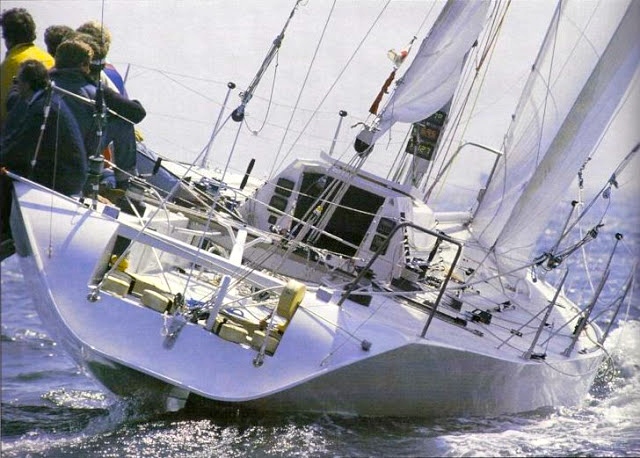 The Dubois 40ft Irish Independent racing in the Solent in the 1987 Admirals Cup. Somewhere in the middle of the tightly-packed crew is Tim Goodbody, and he is on the helm. During this series, he famously out-sailed the legendary Lawrie Smith on a sister-ship during a long tacking duel.
The Dubois 40ft Irish Independent racing in the Solent in the 1987 Admirals Cup. Somewhere in the middle of the tightly-packed crew is Tim Goodbody, and he is on the helm. During this series, he famously out-sailed the legendary Lawrie Smith on a sister-ship during a long tacking duel.
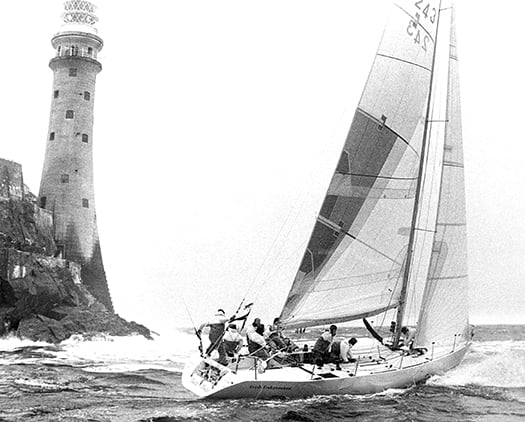 History is made. Irish Independent rounds the Fastnet Rock on Monday August 11th 1987, on her way to the overall win in the Fastnet Race.
History is made. Irish Independent rounds the Fastnet Rock on Monday August 11th 1987, on her way to the overall win in the Fastnet Race.
Sigma 33 Star Tim Goodbody Honoured at Royal Irish Prizegiving
Multiple champion Tim Goodbody's retirement from the Sigma 33 class was saluted at a packed Royal Irish Yacht Club on Friday night when class captain Paddy Maguire honoured the stalwart with an 'Excellence Award' setting out his achievements over 16 years in the one design keelboat class.
In 1999, Goodbody bought his Sigma 33 White Mischief. He was joined by two of his crew that had sailed with him previously, namely Paul McCarthy and Brendan Farrell and was joined by Patrick Cafferky, Paddy Boyd, David Crawford and Richard Cotton to form the basis of the new crew.
From 1999 to the current season they won the UK National Championships, the Irish Championships and all of the club prizes in Dublin Bay Sailing Club (DBSC). They also achieved podium finishes in many other events. Of all races that Tim and the White Mischief crew competed in, Maguire estimated they won '75% of all races sailed; an extraordinary achievement'.
'This performance record clearly demonstrates an exception level of ability and sailing skills that are so rarely if ever achieved in a One Design Class. More importantly it was achieved on a consistent basis throughout', Maguire told the class.
It is the second honour for Goodbody in as many weeks. Last weekend DBSC honoured the Dun Laoghaire sailor at its prizegiving when it uniquely captured Goodbody, his son and grandchildren all as annual prizewinners in Ireland's biggest sailing league.
86 members were in attendance for the prizegiving including no less than five Commodores and the Chairman of Sigma 33 Class Paul Prentice.
The prizes were awarded to :
White Mischief : Tim Goodbody : Sigma Model : Best of Sigma qualities
Leeuwin: Henry Leonard & Bobby Kerr : Corinthian Qualities
Rupert: Dick & Philip Lovegrove : September Series Winner
Three Generations Win Sailing Trophies at DBSC Prizegiving
Three generations of the Goodbody family from the Royal Irish Yacht Club collected prizes at DBSC's annual prizegiving on Friday night. Tim Goodboby, was the winner of both Thursday and Saturday racing overall in the Sigma 33 class. Son Richard also won both Thursday and Saturday DBSC series in the Dragon class. Grandchildren Max and Georgia Godbody were the RS Feva September Series winner of the Mitchell Cup.
DBSC Hon Sec and Historian, Donal O'Sullivan told the annual gathering 'We start tonight with a slight departure from the usual practice. We're marking this evening a most extraordinary and unheard of event - awarding prizes to three generations of the same family - The Goodbodys - Tim, the grandfather, who has graced the podium before on innumerable occasions, Richard, the son, likewise and now the grandson, Max, for the first time ever at a Dublin Bay event. Grandaughter Georgia shared Max's achievement'.
The prizes awarded were: Timothy Goodbody (in the Sigma 33 /White //M//ischief/) Fireseal Sigma 33 Trophy; J.B. Stephens Trophy; Bective Lights Crystal Trophy Richard Goodbody (with partner Rick Johnson) in the Dragon Diva: Oxford & Cambridge Cup; Old Time Cup; RIYC Cup Max Goodbody in the RS Feva 5241 The Mitchell Trophy
The Dublin Bay Sailing Club (DBSC) prizegiving was a highlight of the Dun Laoghaire sailing season and held at a packed Royal St.George YC clubhouse on Friday evening. Prizes, including an array of ancient yachting silverware, were awarded in all of DBSC's 22 classes by Commodore Pat Shannon.
Full list of DBSC Prizewinners HERE.
#dlregatta – With the Kinsale ICRA Nats/Sovereigns Trophy 2015 very successfully concluded last weekend, and a classic Dun Laoghaire to Dingle Race put stylishly in place before that, the feeling of another sailing summer busily in progress is all-pervasive. But while the image projected may well be one of stately progress by the cruiser-racer fleets along the Irish coast, taking in an offshore race here and a regatta there with much leisurely cruising in between, the reality is usually otherwise. For those boats doing significant segments of the programme, it's a case of fitting chosen events into the usual hectic early summer life of work and family commitments and exams and everything else, with the re-location of boats to the next venue being a hurried task undertaken by delivery crews.
Next week sees the mid-season peak of the sailing summer, with the four day Volvo Dun Laoghaire Regatta 2015 in Dublin Bay from Thursday July 9th to Sunday July 12th. In a way it is an amalgamation of all that has has already occurred in this year's season, together with new elements to make it a unique sailfest which celebrates the fact that the citizens of Ireland's capital city and their guests can be conveniently sailing and racing within a very short distance of the heart of town. W M Nixon sets the scene
In the dozen or so years since its inception, the biennial Volvo Dun Laoghaire Regatta has settled itself firmly into the sailing scene as an exceptionally varied event in terms of the boats and classes taking part. There are five regular cruiser-racer classes, plus an offshore division, fourteen one design keelboat classes, and nine dinghy classes. And although there are contenders from Ireland's north coast and from the Cork area and south coast too, together with one gallant entry from Galway, it is essentially an Irish Sea Sailfest, though with a remarkably strong Scottish presence.
However, it was on the coast of Wales at 8.0pm last night that this sailing celebration began, with an ISORA Race starting in Holyhead and heading for Dun Laoghaire to set this large and complex programme into action towards a culmination on Dublin Bay in eight days time with the conclusion of VDLR2015.
2015 marks the Bicentennial of the Royal Dee YC, which was founded in 1815 on the Cheshire shores of the River Dee estuary where northwest England marches with northeast Wales. Originally the Dee Yacht Club (and founded, it's said, a month or two before the Royal Yacht Squadron came into being in the south of England, making the RDYC the second-oldest Royal yacht club in England after the Royal Thames), the Cheshire club became the Royal Dee YC in 1847.
Although the great prosperity of Liverpool in the 19th century saw the club's fleet of substantial yachts gathered in the Dee and then increasingly in the Mersey, by the late 1900s it was looking to the Menai Straits area as the focus of its keelboat events. As well, the completion of Holyhead breakwater in 1873 added a new and important harbour to its list of possible big boat sailing locations, and there was an increase in the number of cross-channel "matches" which the Royal Dee and the Royal Mersey, in conjunction with the Dublin Bay clubs, had already been running for some years.

A Royal Alfred YC cross-channel match from Dublin Bay to Holyhead gets under way in 1888. Cross-channel links were strong in the latter half of the 19th Century, and with the new breakwater completed at Holyhead in 1873, a new venue was available both for the Irish clubs and those on the other side such as the Royal Dee and the Royal Mersey

The bicentenary logo of the Royal Dee YC. In 1815, this club on the Cheshire coast was founded shortly before the Royal Yacht Squadron in the souh of England, whose Bicentennial is being celebrated at the end of July.

Dun Laoghaire saw its first regatta staged in 1828, and participation by yachts from the northwest of England and North Wales was regularly recorded. This is the Royal St George YC regatta of 1871.
So when we say that the Royal Dee has always been a stalwart of offshore racing in the Irish Sea, we're not referring to a story spanning only the 20th and 21st Centuries. On the contrary, it goes well back into the 1800s. And now, with the revival of keelboat sailing in the Mersey with several of Liverpool's myriad docks being given over to recreational use, we have in a sense come full circle with enthusiastic Dublin Bay support of the Bicentennial celebrations reflecting sailing links which go back almost 200 years
The Lyver Trophy is the Royal Dee's premier offshore challenge, and this year it is special, as it's a fully-accredited RORC event counting for points in the annual championship, and a highlight of the ISORA Programme 2015. It's start scheduled for yesterday evening in Holyhead will see the fleet – mostly regular ISORA contenders – sail a course of at least a hundred miles before finishing in Dun Laoghaire. Then as VDLR 2015 gets under way, races in it, combined with the Lyver Trophy results, will count as part of a series towards finding an overall winner of the RDYC Bicentennial Trophy.
Only entrants in the Lyver Trophy race are eligible, and for that race itself – which can be followed on the Averycrest Yellowbrick Tracker - the favourite has to be the Shanahan family's J/109 Ruth, still buoyed up by her great victory in the Dun Laoghaire to Dingle Race three weeks ago.

Back in The Bay – the Shanahan family's J/109 Ruth will be back in her home waters of Dublin Bay after winning the Dun Laoghaire to Dingle Race and completing the Lyver Trophy Race from Holyhead which started last night. Photo: David O'Brien
At the other end of the size scale, the VDLR2015 Dublin Bay programme includes several dinghy classes, and the biggest fleet will be mustered by the International GP 14s, who have designated the racing in Dublin Bay as their Leinster Championship. In an interview with Sailing on Saturday in March, VDLR Chairman Tim Goodbody emphasised that, overall, the event should be seen as a regatta rather than a championship, and for most boats that's just what it will be. But the GP 14s with their great esprit de corps have always done things their own way, and with their compact boat size – albeit comprising a large fleet of dinghies – they reckon they can get in a proper championship while sharing in the fun of the event.
 The brothers John and Donal McGuinness of Moville Sailing Club in Donegal are expected to be among the pace-setters in the GP 14 class with their superb Alistair Duffin-built boat. Photo: W M Nixon
The brothers John and Donal McGuinness of Moville Sailing Club in Donegal are expected to be among the pace-setters in the GP 14 class with their superb Alistair Duffin-built boat. Photo: W M Nixon

The GP 14 Ulsters 2015 were recently won on Lough Erne by Shane MacCarthy & Damian Bracken of Greystones
As to who is favourite, the McGuinness brothers – Donal and John - from Moville in Donegal, with their top-of-the-line Duffin boat built in Northern Ireland, have to be in the reckoning after being top Irish at last year's Worlds on Strangford Lough, but there's fresh blood in the fleet with the newest class developing at Youghal, while this year's recent Ulster Championship on Lough Erne was won by the Greystones duo of Shane MacCarthy and Damian Bracken.
The dozen and more boats coming south from Scotland, most of them substantial cruiser-racers, are testimony to a growing trend in sailing on Europe's Atlantic seaboard. Given a choice of venues, your average yachtie on this long coastline will incline to head south if at all possible. Other things being equal, it's reckoned the further south you go the warmer it is likely to be. And from the upper reaches of the Firth of Clyde, there are times when Dublin Bay might seem like the distant and sunny Mediterranean.
Maybe so, but we'd caution that much depends on the moods and location of that all-powerful weather determinant, the northern Polar Jetstream. In July, so long as it's well clear of Ireland -whether to the north or the south - we will have glorious high summer, and that occurred for the previous VDLR back in 2013, where the photos speak for themselves.
So we hope for the best in looking forward to welcoming a fleet of around 415 boats to Dun Laoghaire between July 9th and 12th, with all four of our in-harbour yacht clubs extending the hand of hospitality in a regatta tradition that goes right back to 1828. But while heritage and ceremonial are all very well in their place, it's the prospect of good sport which energises the participants and their sailing, and with several major contests already logged in 2015, what can we expect on the leaderboards next week?
At the top of the tree, Class 0 has formidable competition, including former Scottish champion Jonathan Anderson racing his XP38i Roxstar against the Royal Cork's Conor Phelan with the Ker 37 Jump Juice, which was one of the best performers in last year's ICRA Nationals at the same venue, and this year again became a force to be reckoned with as the breeze sharpened in the four day Kinsale ICRA Nats 2015/Sovereigns Cup a week ago.
 Freshly squeezed – her storming finish to last weekend's final race of the ICRA Nats/Sovereigns Cup at Kinsale makes Conor Phelan's Ker 37 Jump Juice one of the top contenders in the VDLR2015. Photo: David O'Brien
Freshly squeezed – her storming finish to last weekend's final race of the ICRA Nats/Sovereigns Cup at Kinsale makes Conor Phelan's Ker 37 Jump Juice one of the top contenders in the VDLR2015. Photo: David O'Brien
With a win in the final race, Jump Juice came in second to seasoned campaigner George Sisk's class overall winning Farr 42 WOW (RIYC), the pair of them in turn displacing the early leader, lightweight flyer Mills 36 Crazy Horse (ICRA Commodore Nobby Reilly & Alan Chambers, HYC) down to third in the final day's racing, so Crazy Horse will be hoping for a return of lighter breezes when racing starts next Thursday on Dublin Bay.
In the previous Volvo Dun Laoghaire Regatta in 2013, the most successful boat in was Nigel Biggs' much-modified Humphreys Half Tonner Checkmate XV, but this year the Biggs team is racing as Checkmate Sailing with the newest boat in the fleet, the Mark Mills-designed American-built C & C 30 OD Checkmate XVI. She may be only 30ft LOA, but she's such a hot piece of work with so many go-fast bells and whistles that she has a rating of 1.140 to put her in Class 0.
The oldest boat in the cruiser-racer fleets will be found in Class 3, where the 44ft Huff of Arklow is making an historic return to Dublin Bay racing. Originally built in 1951 by Jack Tyrrell of Arklow to a design by dinghy genius Uffa Fox, Huff is so-called because her concept is reckoned three-quarters Uffa Fox and one quarter Douglas Heard. The latter was the founding President of the Irish Dinghy Racing Association in 1946, and he later went onto to become Commodore of the Royal St George YC and a noted cruising and offshore racing enthusiast with this unusual boat, which is like a very enlarged Fying Fifteen with a lid – in fact, with her 30ft-plus waterline, she was described as a Flying Thirty. In recent years she has undergone a total restoration with Cremyll Keelboats near Plymouth in Devon, and Dominic Bridgeman of the Cremyll group will be racing her with trainee crews in her old home waters of Dublin Bay.

The Flying Thirty Huff of Arklow racing off Dublin Bay while under Douglas Heard's ownership in the 1950s. Built by Tyrrell's of Arklow in 1951, the hugely innovative Huff has recently had a major restoration, and will be making her return to Dublin Bay to take part in VDLR2015.
Among the newer boats on the bay, the 2013 champion Checkmate XV is still very much in the picture, but now she's owned by Howth's Dave Cullen, and took second overall in class in the Kinsale series a week ago. In Dun Laoghaire next week, she's with other Half Tonners at the lower end of the Class 2 rating band on 0.944, almost 200 rating points below the new Biggs boat. Class 2 also includes the Division 3 winner at Kinsale, Richard Colwell & Ronan Cobbe's Corby 25 Fusion (HYC) which bested VDLR 205 Chairman's Sigma 33 White Mischief in a real duel after they went into the final day's racing equal on points, while another Kinsale success story in the Class 2 lineup is Paddy Kyne's X302 Maximus from Howth, overall winner of the Portcullis Trophy for top ECHO boat.

Dave Cullen's modified Half Tonner Checkmate XV will be looking to take the top slot on Dublin Bay after being runner-up in Kinsale. Photo: David O'Brien
In between the two Checkmates on ratings, we find most of the cruiser-racer fleet, with Class 1 shaping up some interesting competition between the likes of Paul O'Higgins Corby 33 Rockabill (RIYC), Kenneth Rumball skippering the Irish National Sailing School's Reflex 38 Lynx, and two very sharp First 35s, Prima Luce (Burke, Lemass & Flynn, NYC & RIYC) and another former Scottish Series champion, John Corson (Clyde Cr C) with Salamander XXI.
This year's Scottish Series Champion and the Afloat.ie "Sailor of the Month" for May, Rob McConnell of Dunmore East, will certainly be racing in the VDLR 2015, but whether or not it's with his all-conquering A35 Fool's Gold (second in class at Kinsale) or aboard another boat (a Flying Fifteen) remains to be seen. And the Top Sailor Count doesn't end there, as there'll be at least four Olympic sailors involved in four different classes, with Robin Hennessy racing in what has all the marks of a quality International Dragon fleet against the likes of former Edinburgh Cup winner Martin Byrne, Annalise Murphy racing in the Moths which will surely be a change from the Water Wag which she raced with her mother Cathy MacAleavy (also another ex-Olympian) last time round, and Mark Mansfield helming John Maybury's J/109 Joker 2. After Joker 2's class overall win in Kinsale, we can expect a battle royal in the J/109s with boats of the calibre of Ruth for the National title fight.

The Shipman 28s find that the sport and socializing which the VDLR guarantees will provide some of their best racing of the year. Photo: VDLR
The J/109s are the queens of an impressive array of One Design keelboats which includes Sigma 33s (where VDLR 2015 Chairman Tim Goodbody's White Mischief is racing under the command of Paul McCarthy), Beneteau First 31.7s, Shipman 28s having one of their best gatherings of the year, Ruffian 23s with a good turnout, the attractive First 21s which are steadily gaining traction as a Dublin Bay class, and best OD keelboat turnout of all is by the Flying Fifteens, nearly all of them under the NYC flag.

Olympians all – in VDLR2013, Olympic sailors Cathy MacAleavey (1988) and her daughter Annalise Murphy (2012) raced the family Water Wag Mollie. But while Cathy will be sailing Mollie again this year, Annalise will be on her own racing a foiling International Moth.

Newest of the oldest – Adam Winkelmann and Doug Smith's new French built Water Wag No.46, Madameoiselle, has been launched in time for the regatta. Photo: Owen McNally

The Howth 17s of 1898 vintage will be the oldest class racing. Photo: David Branigan
Veteran classes include the IDRA 14s from 1946, the Glens from 1945, the Howth 17s of 1898 which pre-date the 1902 Water Wags, and the 1932 Mermaids, the latter being in the interesting position of no longer having an official division in Dun Laoghaire, yet it's a Dun Laoghaire skipper, Jonathan O'Rourke of the National, who continues to dominate the class both at home and away.
With large fleet numbers afloat guaranteed, the shoreside programme is appropriately busy, with the official side of each day's racing concluded by the evening's daily prize-giving at one of the four waterfront clubs. But with so many sailors involved, there'll be action in all the clubs – and at other establishments in Dun Laoghaire - throughout the week. The scene is set, let the party begin at a venue which has been staging regattas since 1828.
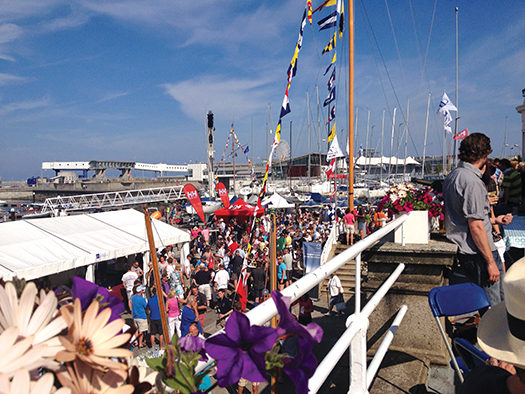
When the summer comes, the après sailing at the VDLR is world class. Photo: VDLR
Further reading:
Download the full entry list for Dun Laoghaire Regatta 2015 class by class below
Download the Sailing Instrcutions for Dun Laoghaire Regatta 2015 HERE
- Dun Laoghaire Regatta
- Volvo Dun Laoghaire Regatta
- Royal St George Yacht Club
- Royal Irish Yacht Club
- National Yacht Club
- ISORA
- Water Wags
- Royal Alfred Yacht Club
- yellowbrick
- GP 14
- Nigel Biggs
- George Sisk
- Annalise Murphy
- Half Tonners
- Tim Goodbody
- Mermaid
- Fool's Gold
- Dragon
- Irish National Sailing School
- Kenneth Rumball
- Dublin Bay
Goodbody Finishes Second at OK Europeans
The final round brought sunny skies and high temperatures, but more of the same shifty, tricky winds that have plagued the week. Bartosz Rakocy (POL) took the title with a fifth place in race nine, while Tim Goodbody (IRL) took second and Jorgen Lindardtsen (DEN) took third.





























